
Contact us
We’re experts in finding you the perfect office space at the best price. Ask us to start your search today – it won’t cost you a penny.

Activity-based working is a flexible working approach that allows employees to choose the best workspace to perform their tasks based on the nature of the activity they are engaged in.
This means that instead of having designated workstations, employees can move around the office to different zones, each designed for a specific task or activity. This office design is a key consideration that must be made in order for this working style to be implemented successfully.
The goal of activity-based working is to create an environment that enhances productivity, collaboration, and employee satisfaction by providing a variety of spaces that cater to different work styles and preferences. These various office design layouts encourage employees to work in a way that suits their preferences, making them more comfortable and productive.
Here are five office layouts that are perfect for activity-based working:
Hot desks are a popular feature of activity-based working office spaces and can offer several benefits to employees and employers alike. These are unassigned workstations that are available for use by any employee on a first-come, first-served basis. There are numerous benefits to using hot desks when looking at different office design layouts and office style options, including increased flexibility, collaboration, productivity and employee interaction.
They are designed to provide flexibility to employees returning to the office. Employees can choose the workstation that best suits their needs, and they are not confined to a single desk or workstation. Hot desks also promote collaboration between employees. Employees from different departments or teams can sit together and work on projects, which can lead to improved communication and collaboration.
This cafe-style layout can help improve productivity as employees can choose a workspace that best suits their needs. For example, team members who need a quiet space to work on an important project can choose a desk in a quieter area. This fluid layout can also help increase interaction between employees from different departments or teams who may not interact regularly, fostering a sense of community in the office and improving overall morale.
Focus booths are an interesting addition for any company looking to change its office style and better accommodate activity-based working. In short, focus booths are private workspaces where employees can work without distraction or additional stimulation, which can be especially useful when working towards a tight deadline. Focus booths may be slightly harder to work into some office layouts, but they are certainly worth further consideration and are a part of many serviced offices.
As explained by Penketh Group, an additional bonus of focus booths is improved inclusivity. If you have employees who are particularly sensitive to external stimuli and find it difficult to work in busier parts of the workplace, private booths can be especially beneficial. When looking at activity-based working, some tasks may require employees to get their heads down, which may be harder for some, so this is a worthwhile inclusion in many cases.

Teamwork is an essential aspect and should be a key part of any decision relating to office style and potential office design layouts. Conference rooms are a great way to facilitate teamwork and are a great addition to any workspace looking to successfully implement activity-based working. As employees return to the office, we have more opportunities for teamwork to be implemented again, and conference rooms are a key part of this.
Most larger office design layouts will already include conference rooms, but they may not be used often aside from formal meetings. Instead, consider opening these spaces up to teams so that they can work together away from the rest of the workforce. With many serviced offices, these group working spaces come as standard and are a popular request from businesses.
Relaxed seating is often overlooked because they aren't seen as 'productive' spaces, but they're just as important when looking to implement activity-based working. Most office layouts can incorporate relaxed seating, and their main purpose is to provide an area for employees to work casually and get some downtime, which can be extremely beneficial.
As explained by Ark Consultancy, downtime "restores attention and motivation, fosters creativity, improves work efficiency and is essential for peak performance". If you want your team to be working at their very best, relaxed seating should be considered next time you're looking at your office-style design. This doesn't need to be an expensive expenditure either, with many serviced offices naturally offering this feature as they become more common in modern workplaces.

Outdoor terraces and garden areas are a great way to offer your workforce a connection to nature and are a central aspect of many modern office styles, especially as many serviced offices incorporate this feature. As we've explained, productive downtime is a central part of modern working, particularly in light of many workers returning to the office after working from home.
Not only are these office areas great for regaining mental focus and clarity, but they're also brilliant for both teamwork and solo work. When in a group, it's a great place for employees to meet up and share ideas and discuss their work in a place that's away from the classic office space. If a business can incorporate outdoor areas into the office layout, we believe that they absolutely should.
If you're looking to relocate to a serviced office space that can cater to the needs of your company and provide the features listed above, which are perfect for activity-based working, get in touch with a member of the Knight Frank team. We can meet the needs of businesses regardless of sector or industry, so you can contact us if you want to learn more.